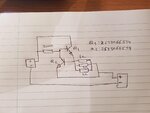Winsu
Full Member level 3

Hi All,
I have posted a very simple circuit to prevent inrush current. It does the job up to 27V and I don't know why at 27V Q1 blows up. I have set the sense resistor to limit the current at 1.8A ( as it is what I would want) and it blows at 27V, and I have changed the current limit and it keeps blowing up. I don't know if I should modified the value of the resistance at the gate of Q1 to improve the performance, but I don't know how that would improve it. I put a capacitor between collector and emitter and it resisted above 30V, but it wasn't limiting the current as it was expected( I guess I modified the voltage dropping at R sense when the capacitor was discharging). What I could do???, any ideas?. I'm thinking to substitute Q2 by an op amp, but I guess the circuit I have posted could do the job with a little change.
The BJT used is 2STD1665T4.
Cheers,
